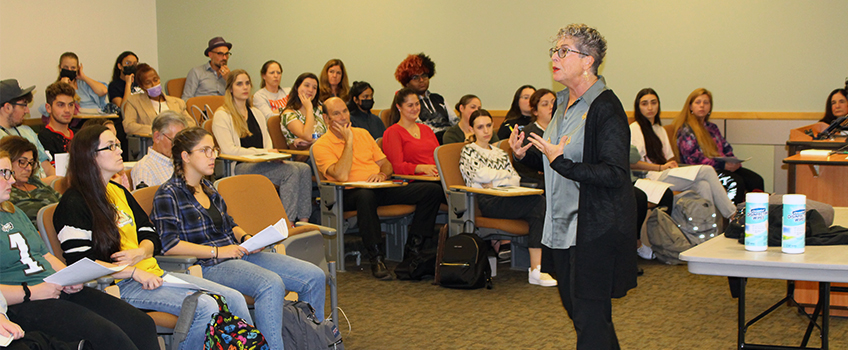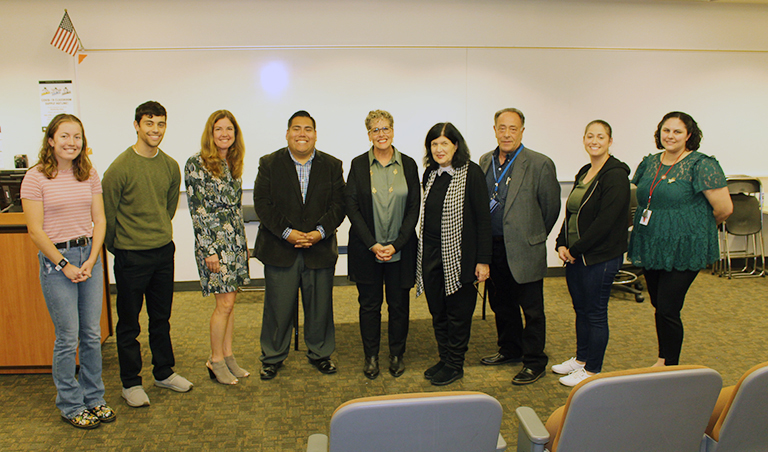Workshop Provides Tools for Teaching the Holocaust

Sheryl Ochayon, the project director of the Echoes and Reflections project and an educator at Yad Vashem in Israel, discusses with a group of about 75 educators the benefits and caveats of using photographs when teaching about the Holocaust.
Galloway, N.J. — Sheryl Ochayon knows how difficult it is to teach the Holocaust.
“It’s a dark, depressing, complicated subject, which is surrounded by misinformation,” said the project director of the Echoes and Reflections project and an educator at the International School for Holocaust Education at Yad Vashem in Israel.
“But if we are going to keep the memory alive, we have to have teachers who know how to do this. How to communicate it to their students and how to use the resources that are available.”
Ochayon hoped to accomplish that during a recent free workshop for educators sponsored by the Sara & Sam Schoffer Holocaust Resource Center at Stockton University. Before a packed lecture hall of at least 75 educators, Ochayon emphasized the impact of Holocaust teaching in middle and high schools and discussed the benefits, and caveats, of using photographs to teach about the historical event.
“The Holocaust is a way to teach and to learn what racism can do, what prejudice can do, what intolerance can do,” she said. “It’s a way to create critical thinking. It’s a way to get people to examine the choices they make because the Holocaust is a laboratory of human behavior under duress. And there’s a lot we can learn from that.”
Ochayon presented the results of a survey showing that students who are taught the history of the Holocaust in high school are more open to different viewpoints, report a greater willingness to challenge intolerant behavior and have a greater sense of social responsibility.
We want to create students, people, who are active, who are not passive. Students who don’t sit by, who aren’t indifferent. If you are wondering if (teaching the Holocaust) is really going to accomplish something, we say it is and we have the results to prove it.”Sheryl Ochayon, project director of the Echoes and Reflections project an educator at the International School for Holocaust Education at Yad Vashem in Israel
Ochayon then showed several examples of Holocaust photographs, most taken by the Nazis to use as propaganda, and cautioned about how they can be misinterpreted without the proper context.
“You have to be aware of what’s going on in a picture, because photographs can be manipulated,” she said. “Photography does not just reflect reality, it interprets reality and can manipulate reality.”
She encouraged teachers to ask questions like: Who took the photo? Was it staged? Were the subjects forced to cooperate?
And the best way to answer some of those questions is through primary voices of the victims, she said. The Echoes and Reflections project (echoesandreflections.org) was created by Yad Vashem, which is the World Holocaust Remembrance Center, the Anti-Defamation League and the University of Southern California Shoah Foundation to empower educators to confidently teach about the Holocaust. It does this through video testimonies from Holocaust survivors, online courses and lesson plans.
Kristian Ward teaches Holocaust and Genocide Studies at Kingsway Regional High School in Gloucester County as part of the dual-credit high school four-credit course offered in Holocaust and Genocide Studies offered by Stockton. He said he’s used oral history testimonies of Holocaust survivors in his class, but the workshop offered some “more tools for my tool box.”
“There’s a lot of resources for Holocaust education, but you’ve got to find them,” he said. “You’ve got to know where they are, so this definitely helps.”
Pairing the photographs with survivors’ testimony can be a very powerful teaching method for students, said Sara Blumenthal, an English teacher at Atlantic City High School, who runs a class on the Holocaust through literature and film.
“Many of my students are being exposed to the Holocaust for the first time. So having this resource is really powerful and helpful,” she said. “I’m walking out with 15 new strategies that I can take back to my kids, which is beyond valuable.”
Hearing comments like these from teachers gives Ochayon such satisfaction, and just confirms that she made the right decision to give up her career as a lawyer to teach Holocaust studies.
“I’m transmitting knowledge, but I’m also watching a new generation of teacher keep it alive for students,” she said. “So no one will ever forget that this happened.”
Gail Rosenthal, the director of the Sara and Sam Schoffer Holocaust Center, was excited with the opportunity to have such a world-renown educator instruct current and future teachers to meet New Jersey’s Holocaust and Genocide Studies mandate in middle and high school.
“We were thrilled to host Sheryl and we know her innovative presentation for Stockton’s School of Education students preparing to student teach in the spring semester and our teachers who are currently educators in grades 5-12 told us Sheryl made a difference by sharing with them new ideas, innovative teaching methods, and other educator resources,” Rosenthal said.
If a middle or high school would like an in-service workshop on Holocaust and Genocide Studies for their teachers, contact the Holocaust Resource Center at 609-652-4699 or gail.rosenthal@stockton.edu.
- Story and photos by Mark Melhorn



